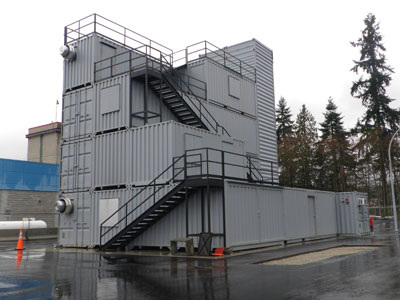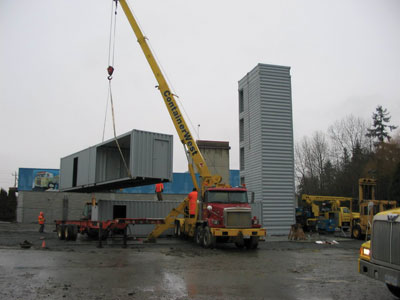
Headlines
News
New grounds for success
A new live-fire training facility in Surrey, B.C., will ensure that firefighters remain prepared to make quick, effective decisions in the field, despite the community’s declining fire rates.
February 14, 2012
By Len Garis and Dan Barnscher
A new live-fire training facility in Surrey, B.C., will ensure that firefighters remain prepared to make quick, effective decisions in the field, despite the community’s declining fire rates.
 |
|
| The new live-fire training facility in Surrey, B.C., meets the needs of the department at a time when firefighters are getting less experience fighting actual fires but need to train to do so. Photos courtesy Surrey Fire Service |
Opened on April 1, 2011, the five-storey structure was custom built from 16 steel shipping containers of various sizes and lengths that were either stacked or placed on end to provide a variety of training opportunities.
Using propane and artificial smoke to create live-fire scenarios, the building meets the NFPA 1001 standards for above-grade and below-grade training and allows Surrey Fire Service to offer its firefighters realistic highrise-type training for the first time – increasingly important in a community with a growing number of highrises.
“There’s been academic research that shows people who operate in high-stress environments, like firefighters, need experience and training to make the right decisions when under stress,” said Surrey Fire Chief Len Garis. “We’re seeing decreasing numbers of fires in Surrey, but we still have to have that readiness and sharpness when we’re responding to incidents.”
Thanks to a strong emphasis on prevention and the use of data to manage resources, the number of structure fires in Surrey has been declining despite steady population growth. Between the fall of 2008 and the fall of 2010, the number of fires declined 26.6 per cent.
While this is good news in terms of the community’s safety, the situation forced the department to look closely at its capacity to keep its firefighters prepared, in the midst of the community’s evolution to a thriving urban centre in Metro Vancouver from a bedroom community.
 |
|
| The five-storey training structure was custom built from 16 steel shipping containers of various sizes and lengths. Photos courtesy Surrey Fire Service
|
The new live-fire building is on the grounds of Surrey Fire Service’s Central Training Facility (CTF), which houses office and classroom space, facilities for confined space and trench rescue, a container for live burns and a garage formerly used for basic interior structural training and simulated rescues.
The CTF’s 1.2-acre site is ideal for the new live-fire facility for a variety of reasons. It’s city-owned, is centrally located in Surrey, is zoned light industrial and is 90 metres away from the closest home. It’s also next door to one of the city’s 17 fire halls, allowing for access to resources such as mechanical staff, a SCBA facility, generators and a forklift.
As well, the CTF has been the hub of a centralized training system introduced by Jim Bond, former deputy fire chief/chief training officer, in the late 1990s, after the city turned the property over to the fire department. Through the CTF, consistent and timely training is delivered to Surrey’s 340 career and 100 volunteer firefighters, augmenting the practices at the halls.
Over the years, as Surrey’s training program evolved and the CTF played an increasing role in firefighter education, the vision for a state-of-the-art training facility in Surrey was born.
That vision started to take a more concrete form three years ago, when Bond and Deputy Fire Chief Bud Livesey travelled to Vancouver Island to look at two training centres built from shipping containers.
Inspired, they returned to Surrey and sat down with the training officers, some building blocks and the NFPA standards to assemble the type of facility they envisioned for Surrey.
At the time, there were few local examples to use as models. While shipping containers are widely used in the United States for fire training, they are less common in Canada.
Surrey initially considered building a concrete structure, but quickly disregarded the idea when it realized its $1-million budget would go a lot further using the container approach, said Livesey, who retired in 2010 but has stayed on as project manager.
Trench rescue facilities
ContainerWest fabricated the containers off site and worked closely with Surrey to customize them, a process that involved removing sections of walls, adding doors and windows, and installing galvanized steel plating on the roof to provide non-skid, stable footing. The pieces were then welded together on site and further connected with wires and ducting, including the propane infrastructure developed with Superior Propane.
Features of the training facility include:
- Propane and artificial smoke piped through the burn rooms.
- A heated and air-conditioned control room with an LCD display for monitoring explosive limits and temperatures in burn rooms, and touch-screen controls for the flow of smoke and propane.
- A simulated highrise, including a ground-floor lobby with fire alarm panel and an internal staircase with access to all four floors and the roof.
- Rooms with non-combustible furnishings to simulate a kitchen and bedroom.
- A simulated garage with swinging garage doors.
- External stairways from the ground to the roof.
- A 48-foot wall for high-angle training.
- A rooftop platform area enclosed with railing, with a removable top rail for aerial ladder rescues.
The revamped CTF property also features an updated confined space infrastructure and a low-speed manoeuvrability course that meets the requirements of the NFPA 1002 Standard for Fire Apparatus Driver/Operator Professional Qualifications.
The choice of clean-burning propane as the fuel source was part of the high environmental standards Surrey brought to the project. No foam is used in the facility, and the site includes extensive water capture and treatment facilities to filter water before it enters the storm-water system. Absorbent pads and an oil separator capture potential contaminants during auto extrication procedures.
Before the facility opened, Surrey was forced to either rent training facilities in other communities or create simulations as best it could. Now, Surrey can provide all of its training in house and give its firefighters more frequent and convenient access to an environment where they can practise applying their skills and making decisions in high-stress scenarios.
“As the number of structure fires decreases, the need for us to provide this kind of training increases so we can make sure they maintain their skills,” said John Lehmann, training officer.
Further, Lehmann noted, the new live-fire building has enabled Surrey to introduce a standards-based proficiency skills checklist for firefighters and fire officers that wasn’t possible with the former facilities. “This will improve the training of the entire department.”
The impact of the new facility is expected to exceed the boundaries of Surrey. The new building, along with other upgrades to the site, has transformed the CTF into a state-of-the-art fire training facility unlike anything else that now exists in Metro Vancouver.
Before the new structure was even completed, it was generating interest among other fire departments and emergency responders, such as the local RCMP detachment’s emergency response team. Surrey also envisions the site being used by corporate and government clients.
Further, the additional capacity will allow Surrey to expand its relationship with the Justice Institute of British Columbia (JIBC). Surrey Fire Service is already a delegated authority of the JIBC, but had never fully exercised that ability due to lack of adequate facilities.
Future plans for the site include adding a crane and lining the garage to more realistically simulate car fires. And in the years to come, the configuration of the container structure can easily be changed to accommodate future firefighting trends.
This flexibility is important, given the considerable changes to firefighter training requirements of the last few decades, said Bob Tewson, a Surrey training officer. “Who knows what firefighters will need to know in 2020 or in 2040?”
Len Garis is fire chief for the City of Surrey, B.C., and an adjunct professor in the School of Criminology and Criminal Justice at the University of the Fraser Valley. Dan Barnscher is deputy fire chief for the City of Surrey, B.C., and manages the department’s training division.
Print this page